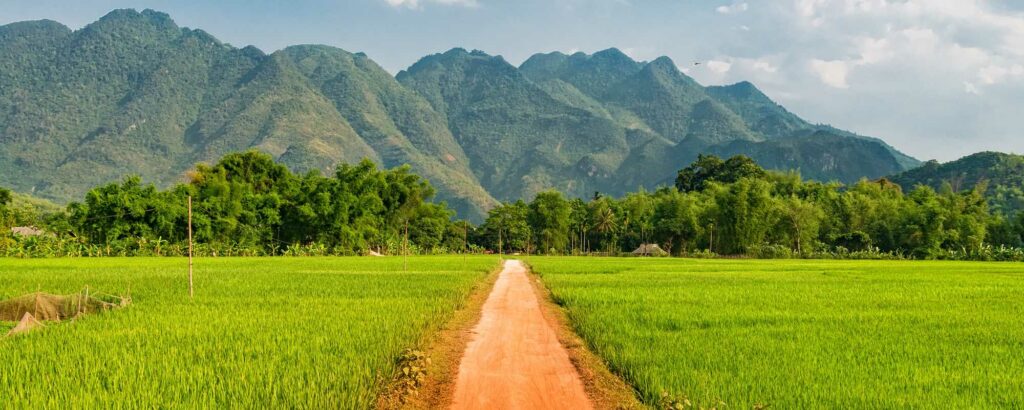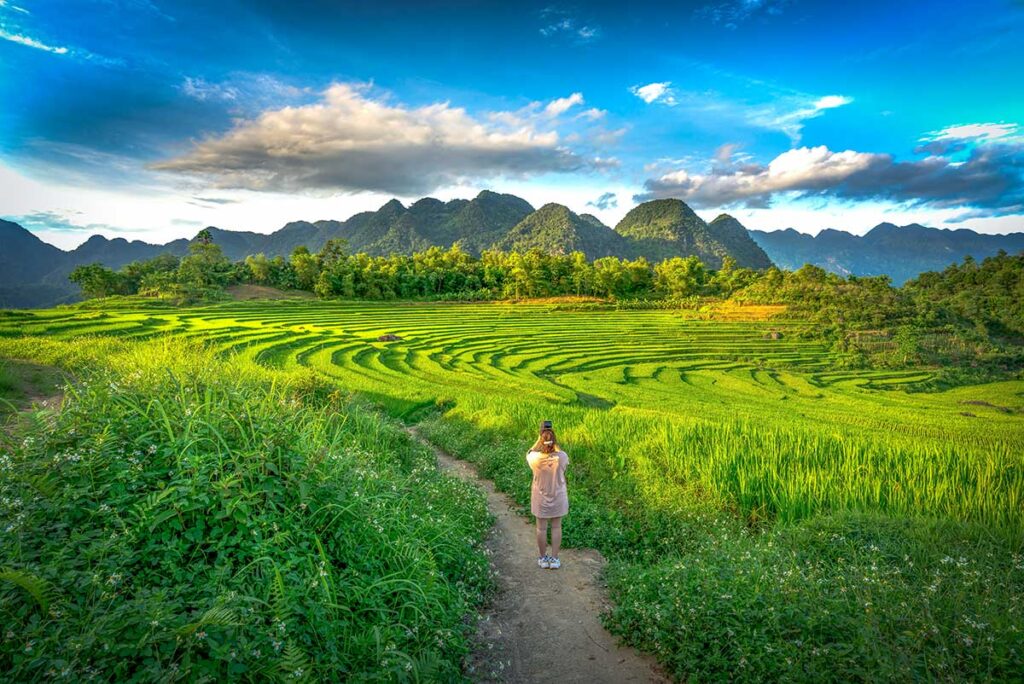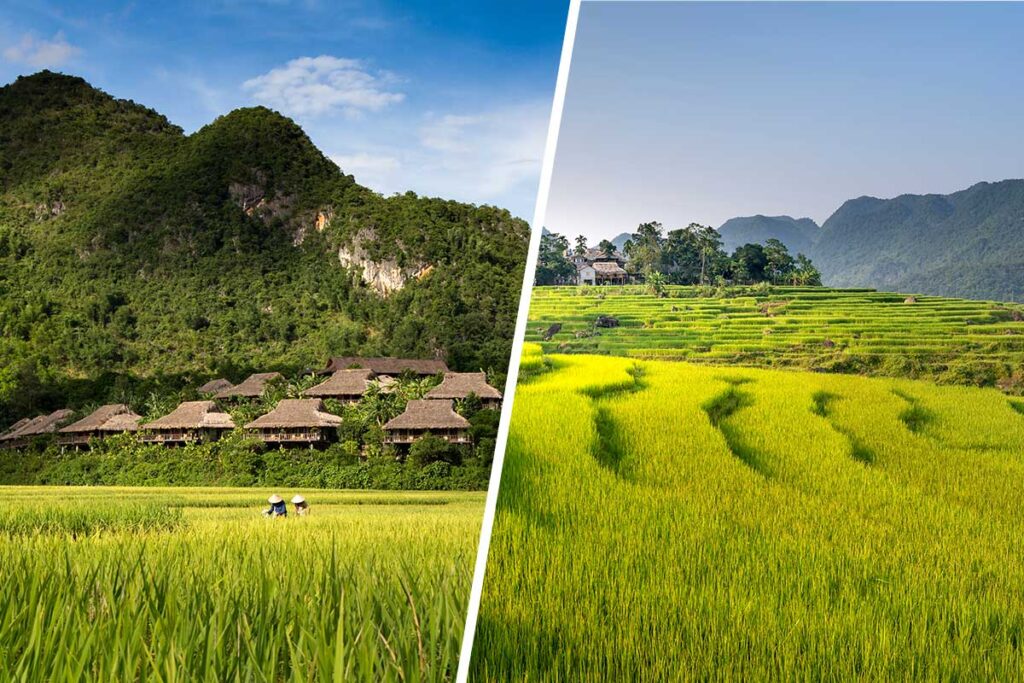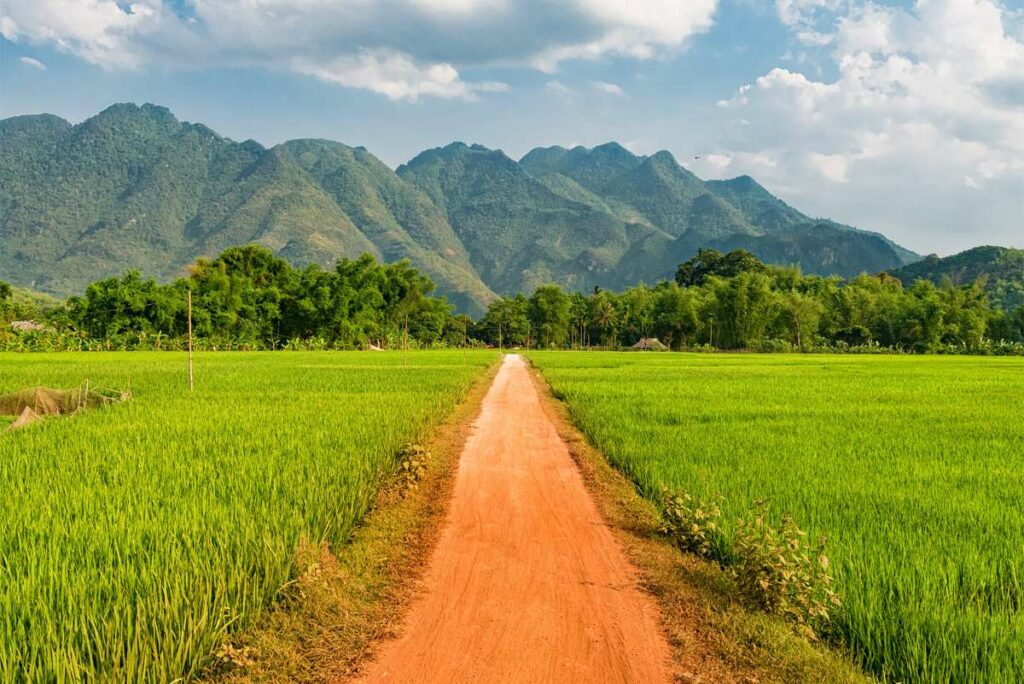Mai Chau – A Valley of Rice Fields and Stilt Houses
Mai Chau is not a city or a town, but a broad, flat valley surrounded by limestone mountains in Hoa Binh Province. The main villages where travelers stay—like Lac and Pom Coong—sit at the center of the valley, where rice fields stretch between wooden stilt houses and narrow cement paths. Most of the local population are White Thai and Black Thai ethnic minorities, known for their traditional clothing, weaving, and wooden houses built on stilts.
Despite being close to Hanoi, Mai Chau still feels quiet and local. It’s a great alternative to the busier mountain towns further north. Instead of big landmarks or crowded attractions, the appeal here lies in the scenery, the pace of life, and the small moments—like biking past a water buffalo, sipping tea on a porch, or watching the fog roll over the mountains in the morning.
Tip: Excited to visit Mai Chau hassle-free?
Check out our fully customizable Mai Chau tours with transfers from Hanoi, unique experiences, and options to combine with Ninh Binh or Pu Luong. Everything is taken care of—so you can just enjoy the journey.
Best things to do in Mai Chau
One of the best things about Mai Chau is its peaceful atmosphere. The wide valley, with rice fields surrounded by mountains, is perfect for slowing down. While we’ve made a list of the best things to do in Mai Chau, the real highlight might just be doing nothing at all—enjoying a hammock at a traditional stilt house, or relaxing in an infinity pool at a comfortable lodge overlooking the rice fields.
Whether you’re into short bike rides, meeting local people, or exploring nearby nature, here are the top things to do in Mai Chau.
1. Cycle through Mai Chau’s rice fields and villages

Mai Chau’s valley is a mix of flat rice paddies, small local villages, and tree-covered hills. Wooden stilt houses sit at the foot of the mountains, and narrow concrete paths cut through the fields and streams. It’s a peaceful and very scenic landscape.

Cycling is the easiest and most enjoyable way to explore it. The land is flat, the roads are quiet, and you can start riding straight from your accommodation. A short loop through the nearest villages only takes about 30 minutes, but it’s easy to spend a whole day if you feel like going further. Most places—whether budget homestays or luxury lodges—have free bicycles available.
Want to know more about possible routes? Read more about cycling in Mai Chau
Pro tip: If you’re not into biking, or if the weather is too hot or rainy, you can hire an electric cart (golf buggy-style) with a driver to take you around the countryside.
2. Explore ethnic Thai villages

As beautiful as the valley’s landscape is, its people and cultures are just as special. Mai Chau is home to mostly White Thai and Black Thai ethnic minority groups, known for their stilt houses, weaving traditions, and strong community life. Many families grow rice, raise animals, and still wear traditional clothing during special events.

Most travelers stay in Lac Village, a more developed area with homestays, shops, and small restaurants—but still home to Thai families. From there, cycling or motorbiking takes you into other nearby villages that feel more local and less touristy. These places give you a better glimpse into real daily life in Mai Chau.
3. Stay in a traditional stilt house homestay

To really experience local life, staying in a traditional stilt house is one of the best things to do in Mai Chau. Many of these homestays are run by Thai families and give you the chance to see how they live. Houses are built from wood and bamboo, raised on stilts, with open sleeping areas and views over gardens or fields. Some are very simple, but others offer more comfort—like private rooms or en-suite bathrooms.

The most popular places for homestays are Lac and Pom Coong villages. But if you venture further into the valley, you’ll find homestays in smaller villages with fewer tourists. These can feel more authentic, though options are more limited the further you go.
4. Take a dip at Go Lao Waterfall

Go Lao Waterfall is a small but scenic spot where water tumbles over rocks into a shallow pool. Depending on the time of year and recent rainfall, the flow can be stronger or weaker. It’s not really a place for swimming, but you can definitely cool off with a dip or sit and relax by the water. On a hot day, it’s one of the most refreshing things to do in Mai Chau — especially if you’re already exploring the lake area nearby.
The waterfall is located a bit further from the main tourist area of Mai Chau. While it’s possible to cycle there, the road is hilly and not ideal for the free bikes most homestays offer. If you’re in good shape and have proper bikes, go for it—but most visitors go by car or motorbike.
Want the full details? Read our guide to Go Lao Waterfall
Pro tip: Go Lao Waterfall is right next to Hoa Binh Lake, so it’s perfect to combine both in one trip. (See next highlight!)
5. Take a boat tour on Hoa Binh Lake

Hoa Binh Lake is a massive reservoir created by one of Vietnam’s largest hydropower dams. In the area near Mai Chau, it feels more like a peaceful mountain lake, with calm water, forested hills, and small villages along the shoreline.
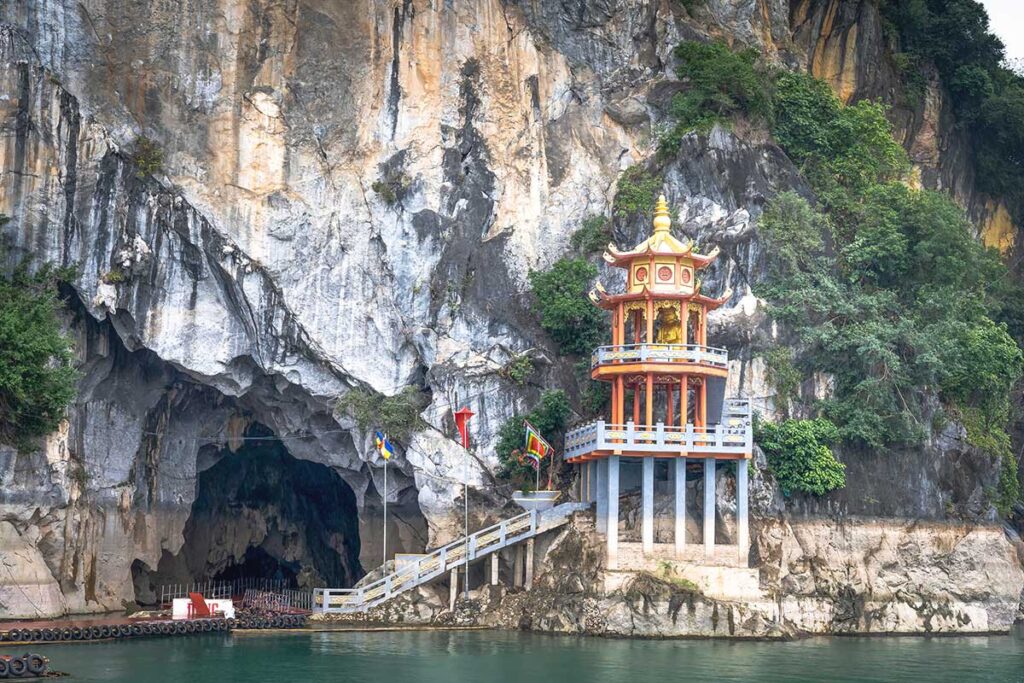
You can drive along parts of the lake for nice roadside views, but the best way to enjoy it is by boat. Short boat tours take you to explore floating fish farms, remote bays, and sometimes even a small cave with a hidden temple inside. It’s a quiet, off-the-path experience that few travelers know about.
Read more about things to do at Hoa Binh Lake
Pro tip: You can also go kayaking here—see the next activity for details.
6. Go kayaking in Mai Chau
Kayaking isn’t the first thing that comes to mind when people talk about things to do in Mai Chau, but it’s still one of the best ways to enjoy the peaceful scenery from the water. There are two main spots to try it, each offering a very different experience.
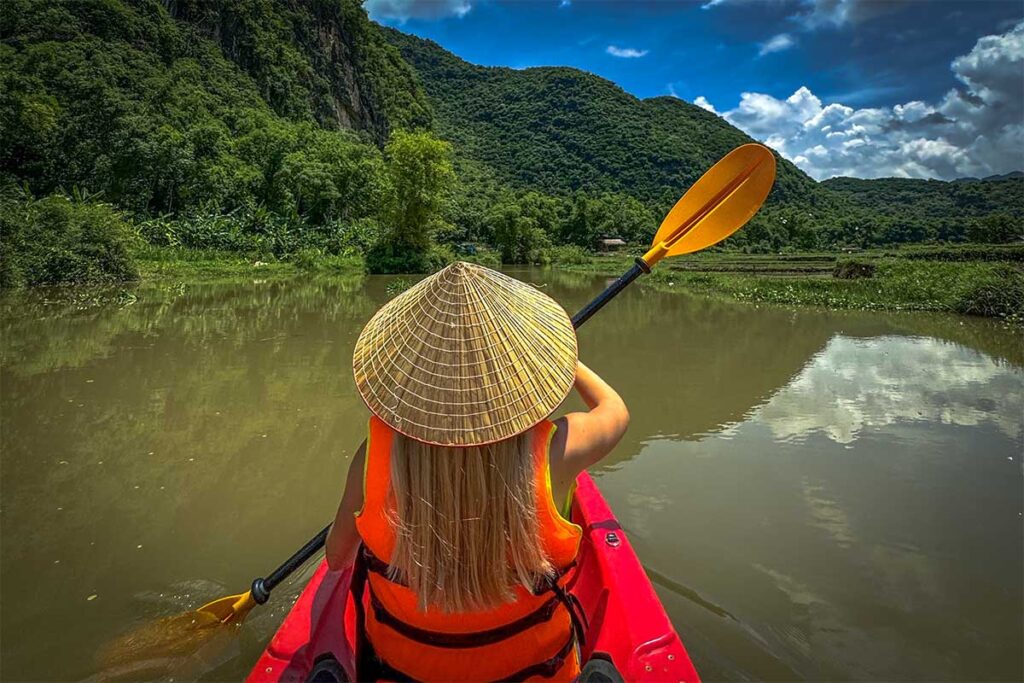
The easiest option is Chieng Chau Kayak Pier, just outside Lac Village. You paddle along a quiet stream surrounded by rice fields, bamboo, and gardens. The route is short — either up and back or a small loop — and may be limited further when water levels are low. But it’s peaceful, clean, and a nice detour during a cycling loop. Equipment is decent, life jackets are provided, and there’s a small riverside café for drinks afterward.
For something more spacious, head to Hoa Binh Lake near Go Lao Waterfall. Here you’ll find calm open water with views of forested hills and Muong villages.
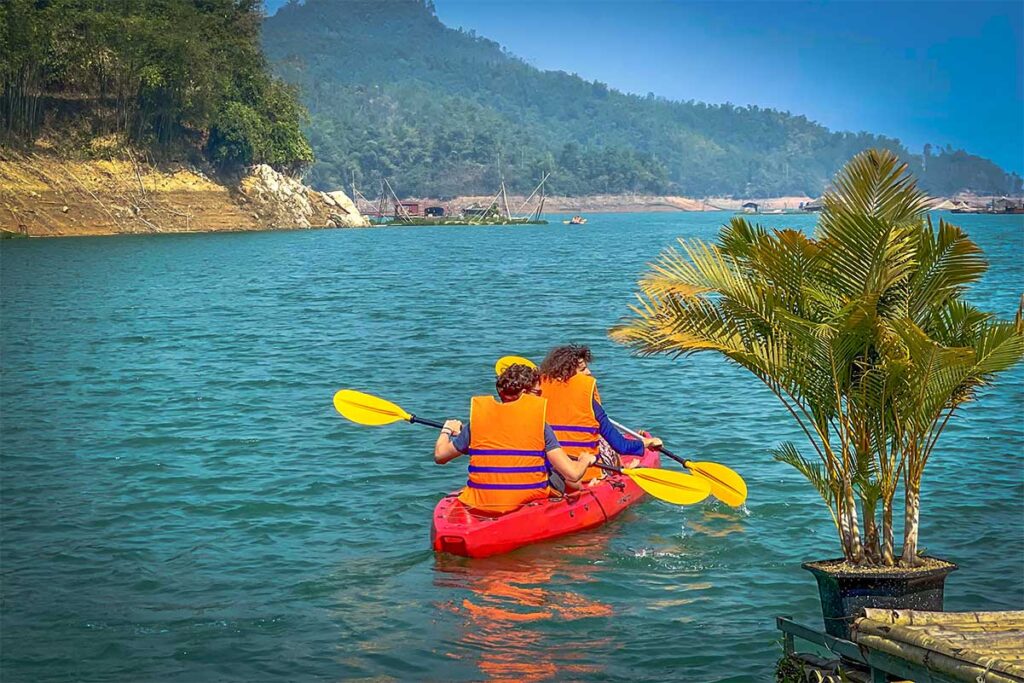
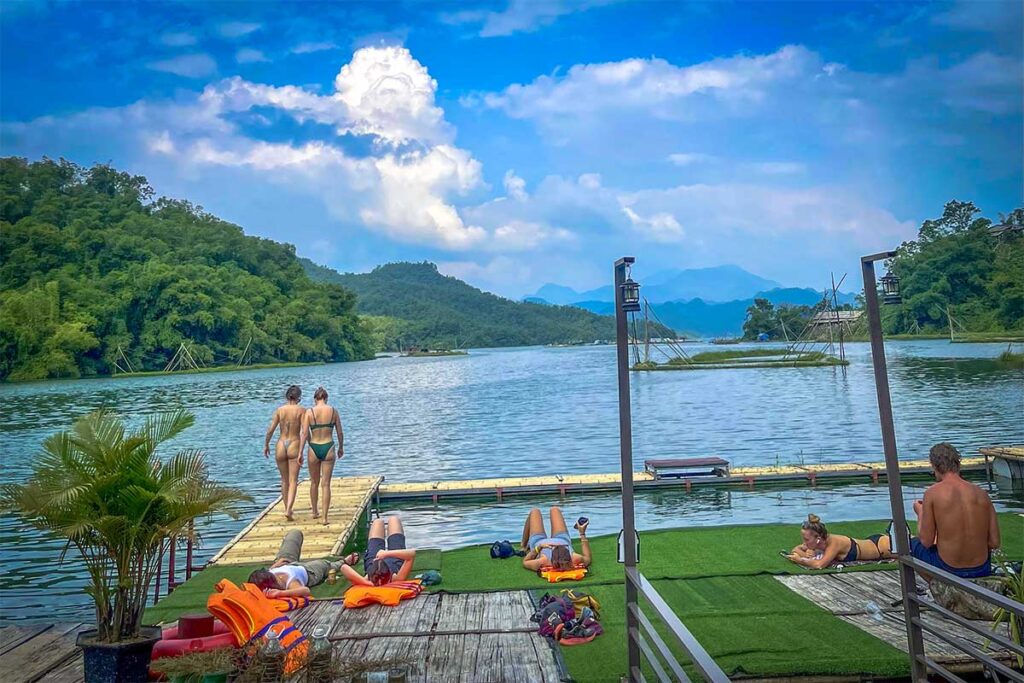
The best spot is Mai Chau Floating House, where you can rent a kayak with no time limit, take breaks, and enjoy a meal or smoothie by the lake. Some nearby resorts like Mai Chau Hideaway also offer kayaks to their guests.
Getting to the lake requires a car or motorbike — it’s too far and hilly to cycle from the valley. But if you’re up for the trip, it’s a rewarding place to slow down and enjoy the scenery.
Read more about kayaking in Mai Chau
7. Drive over Thung Khe Pass and stop at the viewpoint

Thung Khe Pass is the mountain road that connects Mai Chau with the rest of Hoa Binh Province. It winds through limestone hills and offers great views over the valleys below. If you’re traveling from Hanoi to Mai Chau, you’ll pass over it—but many people just drive straight through without stopping.

It’s worth going back to properly experience the pass. Near the top, before the road descends into Mai Chau (if coming from Hanoi), there’s a wide parking area known as Mai Chau Viewpoint. From here, you get an incredible panoramic view of the whole valley, especially on clear days.
Learn the exact location of Mai Chau Viewpoint
8. Visit Chieu Cave after the scenic stair climb
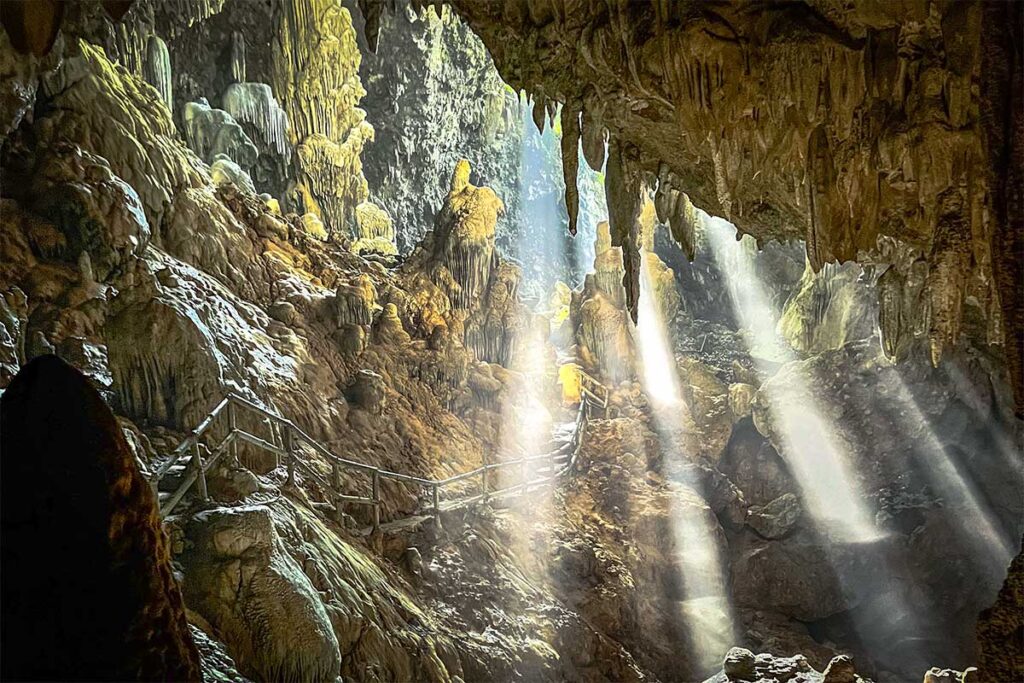
Chieu Cave (Hang Chiều) is one of the most famous natural sights in Mai Chau. The cave has several chambers filled with large limestone formations, and sunlight shining through the entrance creates a dramatic effect, especially in the late afternoon.
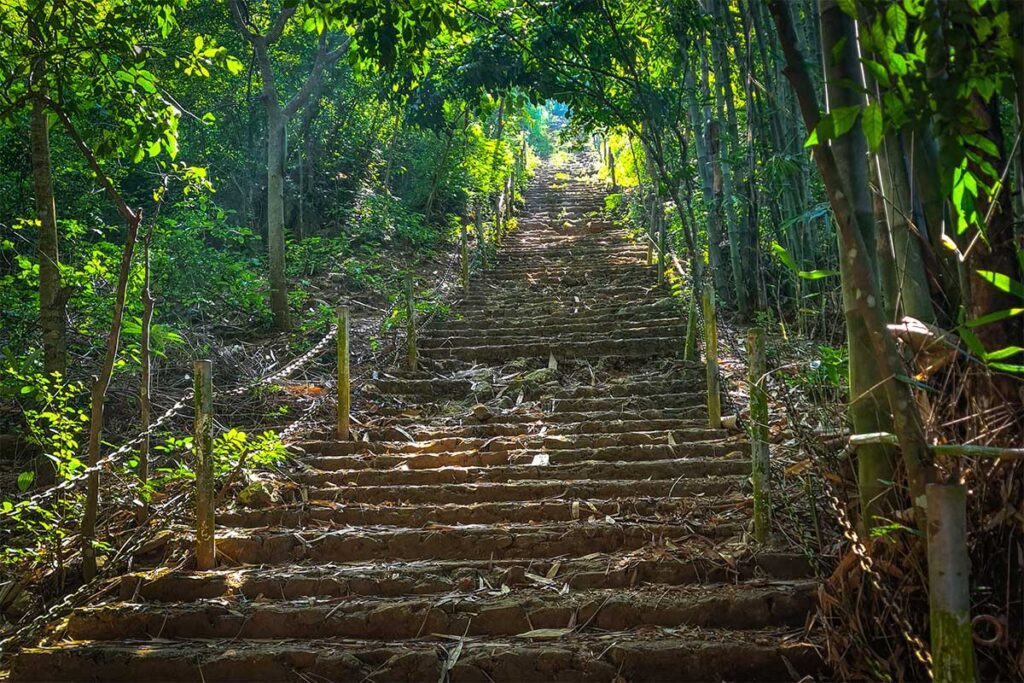
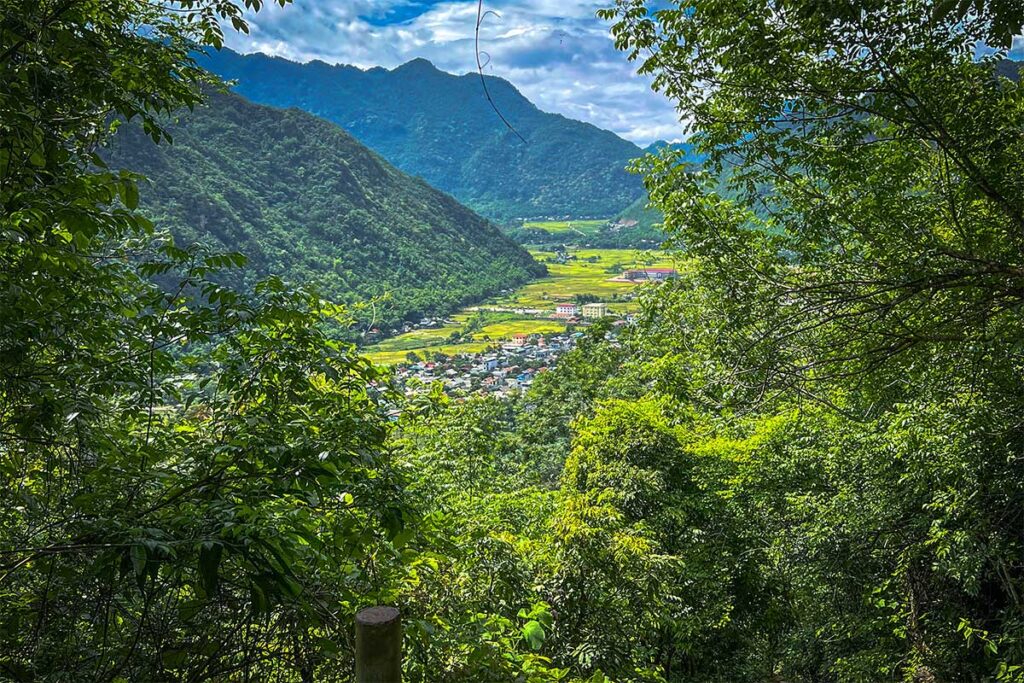
To reach it, you first need to cycle or drive to the base of the hill, just outside Mai Chau town. From there, it’s a steep climb—over 1,200 stone steps—up the hillside. The walk itself offers great views over the valley, and the cave is a peaceful place to rest and cool down after the effort.
9. Join a local workshop (weaving, cooking, or farming)
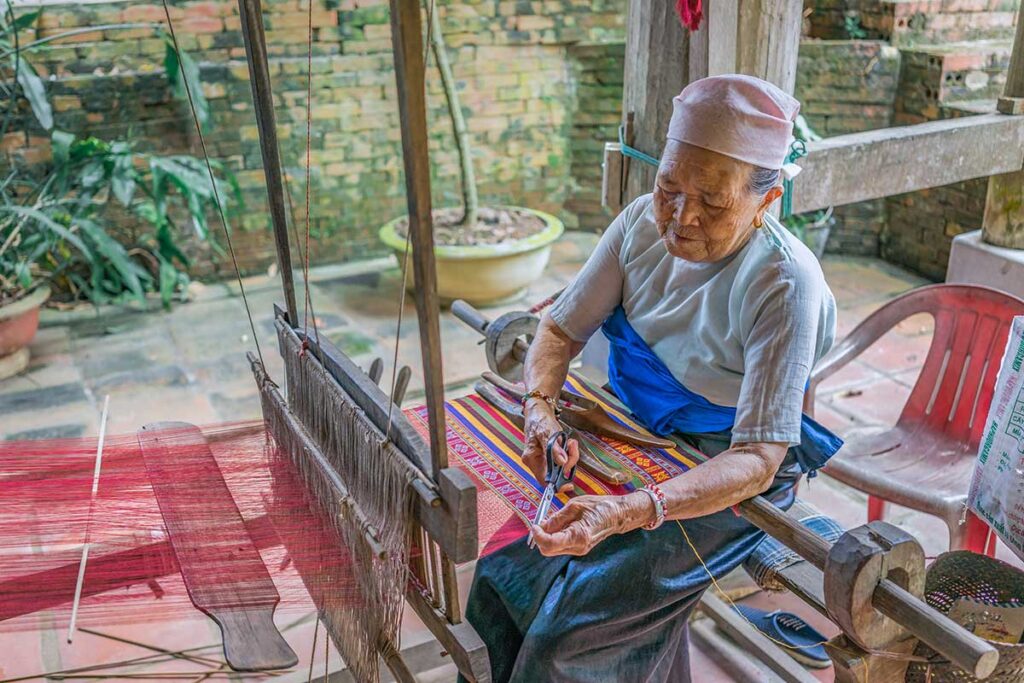
Mai Chau isn’t just about sightseeing—it’s also a great place to join hands-on local experiences. Traditional weaving is the most common, and you can often find Thai women working on looms under their homes. Some homestays and community programs offer short weaving lessons where you can try it yourself.
Cooking classes are also available, usually organized by homestays or local guides. You’ll learn to prepare simple but flavorful Thai-style dishes, often including sticky rice, bamboo-grilled meats, or homegrown vegetables. Farming experiences are harder to find but sometimes included in guided tours—especially during planting or harvest season. Activities might include helping in the rice fields, or even plowing with a buffalo.
10. Watch (or join) a traditional music and dance performance
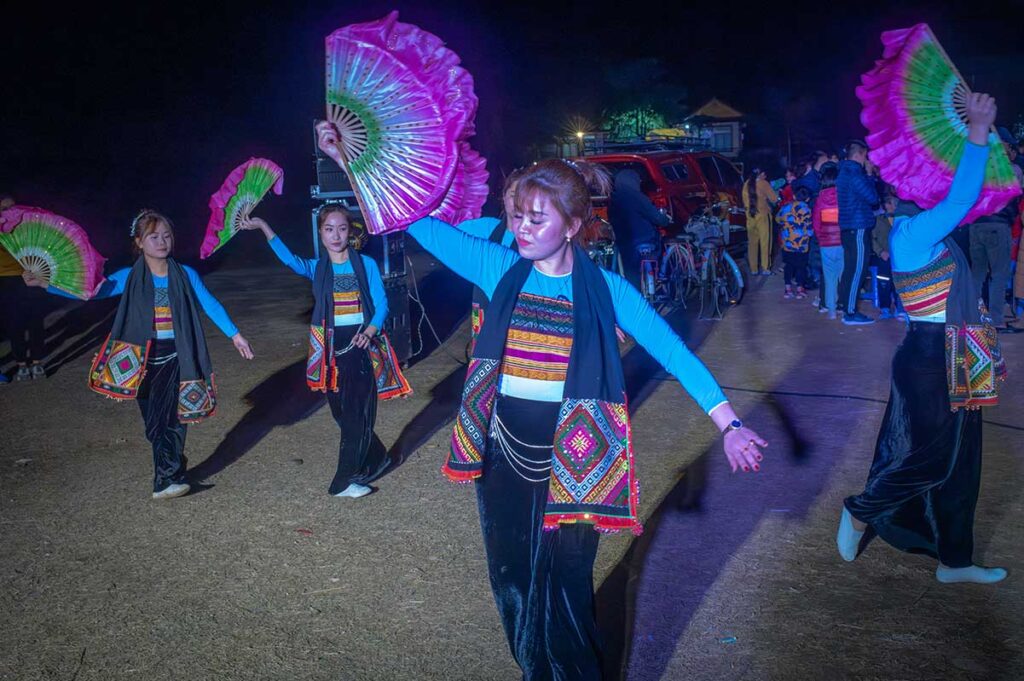
In the evening, many homestays and lodges in Mai Chau offer short cultural shows with traditional Thai music and dance. Performances usually include women in traditional dress dancing in groups and playing instruments like gongs or bamboo flutes. One of the highlights is the bamboo pole dance, where dancers move in and out of clapping bamboo sticks.
Some shows are more interactive, and guests are invited to join for the final dance or share a shot of local rice wine. The setting is usually relaxed — often in a garden or open-air space at the homestay — and gives you a glimpse into local traditions without needing to leave your accommodation.
11. Take a day trip to Pu Luong for trekking and rice terraces

Pu Luong Nature Reserve is located about 1.5 to 2 hours from Mai Chau and is known for its terraced rice fields, bamboo forests, and remote villages. It’s more rugged than Mai Chau and especially popular for trekking. Learn more about Pu Luong

If you have experience driving mountain roads, you can rent a motorbike. Otherwise, it’s better to go by car with a driver or join a guided tour. Trekking is the main activity here, and a local guide makes a big difference — both for navigation and cultural interaction. If you have the time, spending a night in Pu Luong is ideal, but a day trip is very doable. And if you’re based in Mai Chau, it’s honestly one of the best things to do — even if a single day doesn’t fully do it justice.
You can book our Pu Luong day trip from Mai Chau, or join a multi-day tour from Hanoi that visits both Mai Chau and Pu Luong:
12. Visit Pa Co Market and cloud hunt in Hang Kia
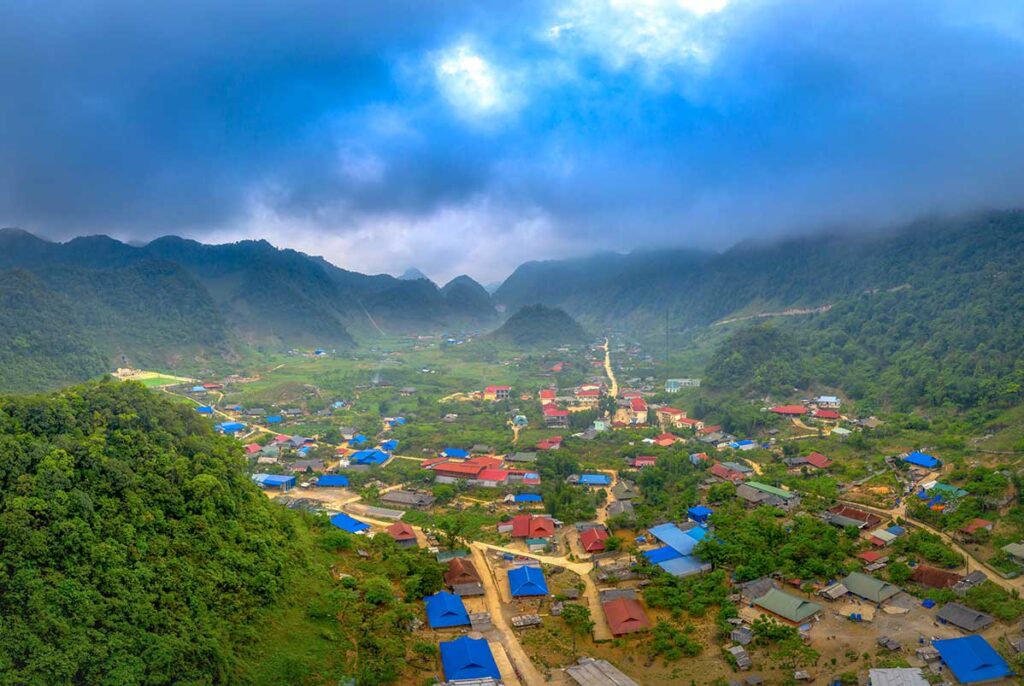
Hang Kia Commune lies about 45 minutes northwest of Mai Chau, high in the hills near the border with Son La. It’s part of Mai Chau District but feels far more remote, with winding roads, misty mountain views, and fewer tourists. The area is home to Hmong communities, and the scenery is completely different from the flat valley.
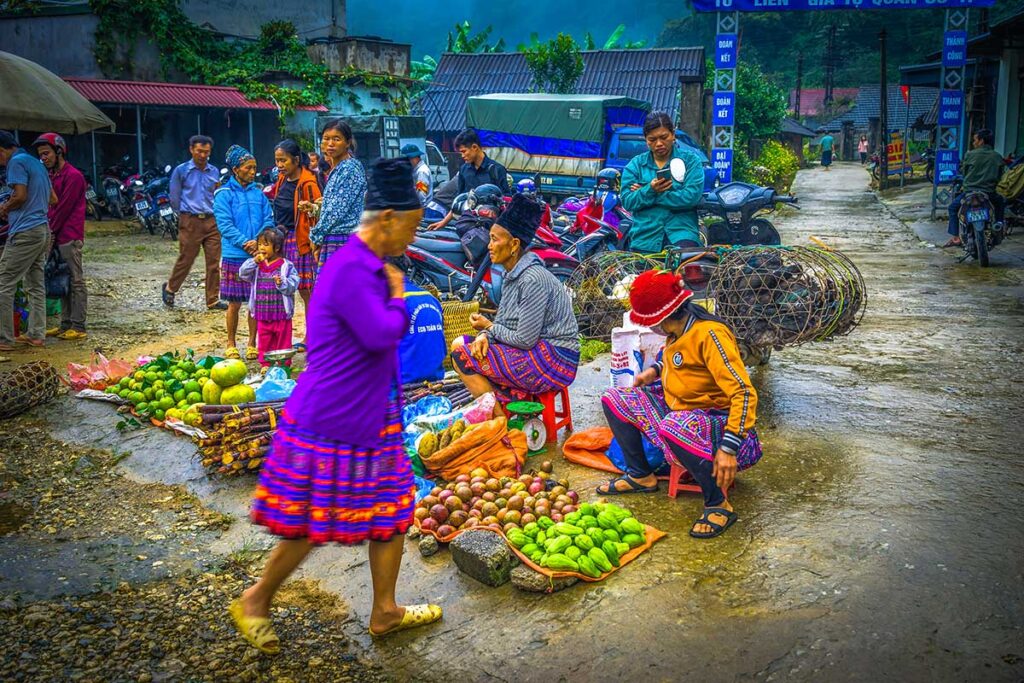
On Sunday mornings, Pa Co Market comes alive with Hmong people in traditional clothing gathering to trade goods, eat, and socialize. It’s not touristy, but visitors are welcome — just be respectful with photography and dress modestly. The market is one of the best cultural experiences in the area.
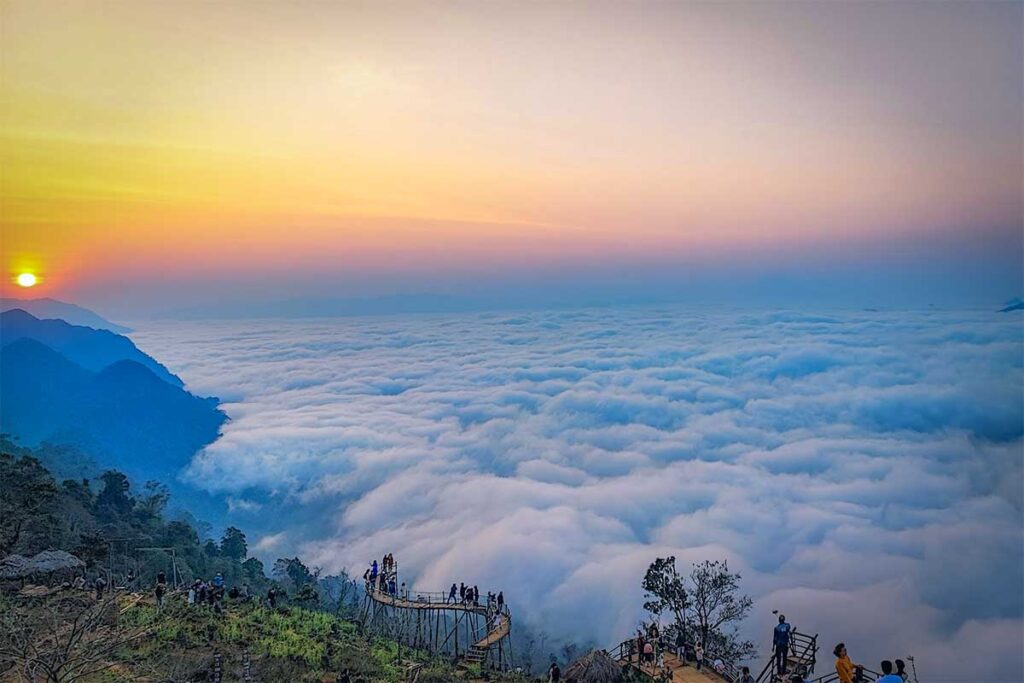
Not far from the market is the Hang Kia Cloud Hunting Viewpoint, where, especially in the early morning, low clouds settle between the mountains. It’s a beautiful and atmospheric stop that makes the drive even more worthwhile.
13. Discover the remote area of Pieng Ve and Panh Waterfall
Pieng Ve is one of the more remote corners of Mai Chau District, tucked deep into the valley. Getting there takes time, but the drive itself is part of the experience — winding through hills, rice paddies, and quiet ethnic villages. Some homestays and eco-retreats are hidden in this area, perfect if you want to avoid the more touristed villages.

Unlike the main Mai Chau Valley, which is mostly flat, Pieng Ve has terraced rice fields and more varied terrain. You’ll also find Panh Waterfall, a small but scenic spot where you can rest and enjoy the natural setting. It’s not as well-known as Go Lao, but that’s part of the appeal.

If you’re the kind of traveler who enjoys discovering hidden corners and local life, this is easily one of the best things to do in Mai Chau — both for the destination itself and the beautiful journey to get there.
14. Taste local food specialties in a family kitchen
Mai Chau’s food is simple, hearty, and closely tied to the local ethnic traditions. One of the most common dishes is sticky rice cooked in bamboo (com lam), often served with grilled meats, wild vegetables, or sour bamboo shoots. You’ll also find mountain herbs, banana flower salad, and sometimes even smoked buffalo.
The best way to try these dishes is in a family-style dinner at a homestay, where everything is home-cooked and served in generous portions. Some places also offer cooking classes, where you can learn to prepare a few local recipes using fresh garden ingredients. Local restaurants around Lac and Pom Coong villages also serve Thai specialties in a more casual setting.
Best time to visit
Mai Chau can be visited year-round, but your experience will vary depending on the season. The best time to visit depends on your preference for scenery, temperature, and activities. Below, we’ve summarized the key seasonal highlights:
Weather and Seasons
Mai Chau has two main seasons: a dry season from November to April, and a rainy season from May to October. Unlike higher mountain regions like Sapa, Mai Chau sits in a lower valley, so it’s generally warmer in winter and more humid in summer.
- Dry season (Nov–Apr): Comfortable temperatures, clear skies, and great conditions for cycling, trekking, and exploring local villages. Winter months (Dec–Feb) can be cool, especially at night, but not too cold.
- Rainy season (May–Oct): Warm and humid, with afternoon showers that rarely last all day. This period also brings lush greenery, flowing waterfalls, and rice fields at their most vibrant.
Tip: Rain shouldn’t stop you from visiting — just pack a light rain jacket and plan morning activities when weather tends to be clearer.
Rice fields and Scenery
Mai Chau is one of the few places in northern Vietnam with two rice growing seasons each year, making the valley green or golden for most of the year.
- March to May: The first rice season. Fields turn from fresh green to golden in May, when the spring harvest takes place.
- September: The second and most scenic harvest. Fields are golden and stunning — ideal for photography and local cultural experiences.
- June to August: Growing season. Fields are vibrant green, though it’s the peak of the rainy season.
- October to February: Post-harvest and winter. Rice fields are bare, but the valley remains charming with clear skies and cool air.
Tip: If rice fields are important for your trip, aim for April–May or September. These months offer the best combination of weather and scenery.
Overall best time to visit
- March to May is often considered the best time to visit Mai Chau, with warm dry weather and lush rice fields.
- September is the most photogenic month, thanks to the golden harvest and improving weather.
- October and November offer perfect trekking weather, though the fields are already harvested.
Want more detail? Read our full guide to Mai Chau’s weather by month to plan your visit around rice seasons, temperature, and travel conditions.
Where to Stay in Mai Chau
Mai Chau has no city center — it’s a rural valley made up of small villages, rice fields, and scattered homestays. Most travelers stay in or around Lac and Pom Coong, the two main tourist-friendly villages located right next to each other. This is where you’ll find the highest concentration of accommodation, from simple stilt-house homestays to stylish lodges with pools. Shops, restaurants, and most activities are also centered here.
Village or Valley?
You can choose to stay inside the villages, where things are more social and convenient, or in the surrounding countryside, where accommodations feel more peaceful and isolated. Nearly all places are run by local families or small businesses — so instead of large hotels, expect homestays, lodges, and retreats.
Off-the-beaten-path options
If you want to stay somewhere quieter and more remote, there are a few options:
- Hang Kia commune offers basic Hmong-style homestays in the mountains, about 45 minutes from the main valley.
- Deeper in the valley, you’ll find scattered eco-retreats and family-run homestays that are harder to reach but feel more hidden and authentic.
- Hoa Binh Lake has a handful of lakeside stays, including the popular Mai Chau Floating House. The scenery here is completely different — forested hills instead of rice fields — and it’s a good base for kayaking, but not ideal for cycling or exploring local villages.
Food & drinking
Restaurants
There are a few restaurants in Mai Chau, but it is more likely that you eat at your homestay, hotel or resort. Eating at a homestay overnight is often included in the price and the food is great. There is no menu. Classic, country-style dishes are served from a set menu for lunch and dinner. It is simple and nutritious and a good fuel to explore the region.
The restaurants in Mai Chau can be find in the main villages, surrounded by shops. Expect mainly local dishes. For western food you want to check the restaurants that are part of a resort.
Nightlife
There is no real nightlife in Mai Chau; which is only a good thing for a town in this setting. But every night there are traditional dance shows being giving to welcome the new guest. You can find these shows at some of the hotels and resorts.
How to get there
Mai Chau does not have a railway station or airport. If you want to use this, it is best to first travel to Hanoi and from here travel to Mai Chau.
Skip the hassle – book a full Mai Chau tour
All our Mai Chau tours include transfers from Hanoi, local activities, and everything arranged for you. Some also combine Pu Luong or Ninh Binh for a seamless, door-to-door experience.
Busses to Mai Chau
The easiest and fastest way is by minibus from Hanoi. These minibuses from Hanoi to Mai Chau are also included in most Mai Chau packages with accommodation.
Direct buses to Mai Chau leave from My Dinh bus station in Hanoi at 6 a.m., 8:30 a.m. and 11 a.m. The journey costs around 80,000-100,000 and lasts between 3.5 and 4 hours. If you want to stay in the villages of Lac or Pom Coong, ask the bus driver to drop you off there. You will be dropped off at the crossroads, were you can get a taxi to your accommodation.
Buses return to Hanoi at 9 a.m., 11 a.m. and 1 p.m. Host families in your homestay or hotel can reserve this bus for you and arrange for you to be picked up from the village.
Getting around Mai Chau
The Mai Chau Valley is compact and quiet, making it easy to explore without needing complex transport. Here are the main ways to get around:
Cycling
The most popular and relaxing way to explore. The valley is flat, the roads are quiet, and bikes are often free at homestays and lodges. Perfect for short loops through rice fields and nearby villages.
Scooter / Motorbike
Ideal for reaching further places like Go Lao Waterfall, Hoa Binh Lake, or more remote villages. Roads are generally quiet, but some sections are steep or uneven — best for those with prior experience.
Walking and Trekking
There are no major trekking routes in Mai Chau, but you can take short walks through rice fields and nearby villages. For real trekking, consider a day trip to Pu Luong Nature Reserve.
Taxis and Cars
Taxis are limited and not available inside the villages. For short trips, arrange one in advance. For longer distances, hire a car with driver — pricing is fixed by route or duration, not by meter. A good option for day trips to Hang Kia, the lake, or the waterfall.
Itinerary 2 days in Mai Chau
Not sure how to spend your time in Mai Chau? Here’s a simple 2-day itinerary with a mix of nature, culture, and relaxation. Perfect for first-time visitors.
Day 1
- Cycle through rice fields and quiet countryside roads
- Visit nearby Thai villages like Lac and Pom Coong
- Join a local workshop (weaving or cooking)
- Relax in the afternoon with a rice field view from your homestay or lodge
- Watch a traditional music and dance performance in the evening
Day 2
Option 1: Pu Luong Day Tour
- Drive or join a tour to Pu Luong Nature Reserve (1.5–2 hours)
- Go trekking through terraced rice fields and ethnic villages
- Return to Mai Chau in the late afternoon
Option 2: Mai Chau Scenic Loop by Car or Motorbike
- Drive over Thung Khe Pass and stop at Mai Chau Viewpoint
- Visit Go Lao Waterfall
- Enjoy lake views or go kayaking at Hoa Binh Lake
Tips for Traveling to Mai Chau
Recommended days to stay
There aren’t many big sights to tick off in Mai Chau, but that’s exactly the point. If your goal is to relax, cycle through the rice fields, and soak up the atmosphere, two full days is enough. If you want to explore further — like taking a trip to Pu Luong or visiting remote areas like Hang Kia or Pieng Ve — consider staying three or four days.
Where to go next?
Mai Chau connects well with several other destinations in northern and central Vietnam:
- Pu Luong Nature Reserve – Closest and easiest next stop. Can be combined with Mai Chau in one tour.
- Hanoi – Required transit point if you’re heading to Ha Giang, Sapa, or Halong Bay. If short on time, it’s best to choose either Sapa or Mai Chau — not both.
- Ninh Binh – Reachable by car; connects well to southbound travel to Phong Nha or Hoi An.
- Moc Chau & Son La – A good option for more remote scenery, tea plantations, and minority culture.
Mai Chau with kids
This valley is one of the best places to travel in Vietnam with kids. Staying at a lodge or resort with a pool is a great way to keep kids comfortable in warmer months. It’s also an easy place to introduce children to Vietnam’s ethnic cultures, with hands-on experiences like weaving, rice planting, or simply biking through villages and seeing how people live.
Language
English is commonly spoken at resorts and more developed accommodations. In local homestays and village restaurants, English may be limited, but most places have an English menu or use translation apps. People are welcoming, and a smile and simple gestures go a long way.
ATMs & Paying for Things
There are no ATMs in the main villages like Lac and Pom Coong. The closest ATM is about 2 km away in the nearby town, but it’s not always reliable. It’s best to bring enough cash from Hanoi, especially if staying at a homestay or planning to visit remote areas. More mid-range lodges and resorts now accept card payments, but some local restaurants and many homestays still prefer cash.
What to bring
Mai Chau is rural, with few shops and limited services. Don’t count on buying anything last-minute. Bring what you need: sunscreen, mosquito spray, light layers for hot days and cooler nights, and sturdy shoes if you plan to walk or explore outside the villages. If visiting in the rainy season (May to September), pack a light rain jacket or poncho. During winter (December–February), mornings and evenings can be chilly, so it’s smart to bring a warm layer.
